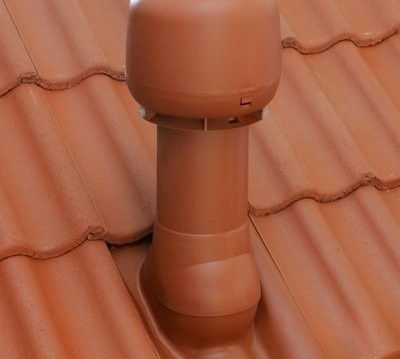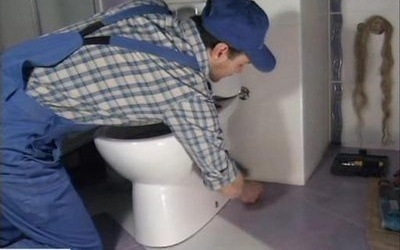Installing a sewer fan pipe: do the ventilation correctly
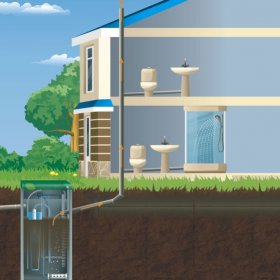
A healthy microclimate in a house consists of several factors. It would be a mistake to think that it depends only on the presence or absence of an air conditioner and a properly installed ventilation system. The most important component of the fresh atmosphere of the home is a well-mounted fan pipe. She successfully copes with odors emerging from the sewer. The presence and normal functioning of the structure guarantees the absence of “aroma” of sewage and loud unpleasant sounds in the house when draining the water.
Content
The principle of the fan pipe
This device is designed to provide ventilation to the sewage system. It connects the construction of sewer pipes with the atmosphere or with a specially made ventilation duct. The shape and length of the device can be arbitrary. You can find straight, bent at an angle, vertical and horizontal details.
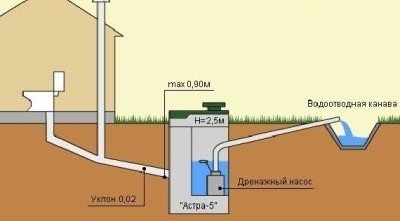
When arranging a sewer system, the fan pipe, a ventilated riser, is most often installed. The functioning of the device prevents the smell of sewage from entering the apartment.
The principle of operation of a fan pipe is quite simple. Wastewater discharged into a vertical riser creates a vacuum in the pipeline. In part, it can be compensated by water in siphons of plumbing equipment. But with a powerful drain or a great height of the riser, the vacuum formed in the sewer pipe, with a characteristic "champing" sound, breaks the equipment hydraulic locks, draining the siphons. In this case, there are no obstacles to the smell from the sewer.
In systems equipped with a fan pipe, everything happens a little differently. The vacuum created in the sewer pipeline does not have time to “suck” water from the siphons. This is prevented by atmospheric air, which begins to be sucked into the system simultaneously with the appearance of vacuum in it. Thus, water locks in the sanitary equipment remain in their places and successfully prevent the penetration of unpleasant sewer odors into the apartment.
How to properly design a fan ventilation system and how to avoid mistakes while reading this, read in our material:https://aquatech.tomathouse.com/en/kanalizaciya/drugoe/ustrojstvo-fanovogo-stoyaka.html
When is ventilation necessary?
According to the norms, a sewage pipe for sewage is mandatory installed in the following cases:
- The building has more than two residential floors, each of which is equipped with a sewage system and water supply.
- The one-story building is equipped with a swimming pool or has other devices that can produce one-time drains of a significant amount.
- Sewer risers in the building have a diameter of 50 mm.
Low-rise buildings are usually built without installation of ventilation. However, it should be borne in mind that this is advisable only for small one-time drains. Determining their level is quite easy. Installation of the device will be considered necessary if the flow of wastewater can completely block the vertical riser.
The most common situation: the toilet is most often installed on a pipe with a diameter of 110 mm, the opening of the drain tank has a cross section of 70 mm and a pipeline with a diameter of 50 mm leaves the bathtub.
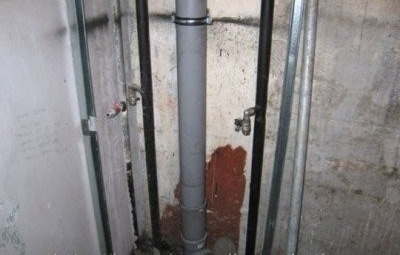
In multi-storey buildings, where water supply and sewerage are connected to each apartment, the installation of a fan pipe is necessary. The riser is displayed on the roof
It becomes clear that the simultaneous functioning of one bath and one toilet will not create problems. Even if a dishwasher or washing machine and sink are connected to the sewers, they will not be able to seriously increase the volume of a one-time drain. Therefore, ventilation in this case is mounted as desired. But if several bathrooms and toilet rooms are planned in the house, it becomes impossible to do without equipment.
Ventilation must be installed not only in engineering systems, but throughout the house. You will learn how to do this correctly from our article:https://aquatech.tomathouse.com/en/ventilyaciya/pritochnaya-ventilyatsiya-v-chastnom-dome.html.
Features of the installation
Installation of such a riser can be carried out independently. First of all, for this you will need to purchase suitable pipes. You need to understand that the design is a direct continuation of the sewer pipeline, so the pipes from which the main system is assembled are quite suitable for it.
It should be ensured that the cross section of the installed element coincides with the sewer hole or is slightly larger. Practice shows that the optimal diameter of the fan pipe is 110 mm.
In order to provide the pressure and temperature differences necessary for creating traction, it is recommended to choose a place in the heated room for the initial section of the riser. The final section, in contrast, needs to be located in the cold. It should be an open place, then the draft created in the pipe will unpleasantly remove unpleasant odors into the atmosphere. Actually installation of the device is extremely simple: installation of the structure is carried out in a pre-prepared ventilation duct.
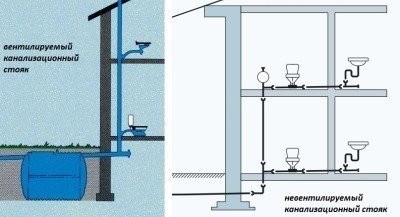
There are two almost equivalent options for a competent arrangement of a fan pipe: venting the riser to the roof and installing a check valve
Check valve system
Equipment put in place can be equipped with a special system called check valve. It enables normal functioning without venting the riser to the roof. In addition, the device is necessary for:
- Correction of insufficient slope of the sewer pipe.
- Prevention of ingress of mechanical impurities and rodents into the system.
- Obstacles to returning sewage to plumbing devices.

The non-return valve on the fan pipe must be installed without using all kinds of coatings and silicone. The surface must be clean and dry.
Depending on the type of check valve, it can be installed outside or inside the element. The device is directed towards the movement of drains, its elements, made in the form of petals, should be curved towards the plumbing fixture. Internal installation involves thorough cleaning and subsequent degreasing of the inner surface of the pipe, where the insert will subsequently be installed. Experts strongly do not recommend the use of various lubricants during installation, including silicone, specially designed for sewerage. All installation work is carried out only on dry surfaces.
Sewer ventilation riser
Traditionally, the upper part of the fan pipe is displayed on the roof in the form of a ventilation riser.According to the recommendations of construction SNiPs, the height of the structure should be at least 0.5 m on a pitched roof, 0.3 m on a flat non-operated surface and 3 m on an operated roof. At the same time, the minimum distance from the riser to the openable balconies or windows horizontally should be at least 4 m. It is strictly forbidden to combine the outlet of the fan pipe with stove chimneys or ventilation.
If there are several sewer risers in the house at once, they can be connected with one exhaust part. In this case, the cross section of the pipe selected for its arrangement should be equal to or greater than the diameter of the risers themselves. For most buildings, the diameter of a single exhaust part will be 110 mm. The combined exhaust elements are stacked with a slight slope, of the order of 0.02%, directed towards the movement of gases.
Taking the device to the attic is strongly discouraged. It is also forbidden to install the outlet of the fan pipe directly under the roof overhang, since snow falling and sliding from the roof can easily damage it. All sorts of additional designs for the hood, such as windbreakers or baffles mounted on the outlet of the sewer riser, will not give the expected effect. On the contrary, according to experts, they provoke the appearance of condensate in the system, which is fraught with blocking of the outlet holes during its possible freezing.
You also need useful material about which pipes to choose to make the sewer ventilation, and what factors should be taken into account when designing:https://aquatech.tomathouse.com/en/uchebnik/montazh/ventilyaciya-kanalizacii-v-chastnom-dome.html
A functioning sewage system without ventilation is possible. But will the landlord where such a system is installed agree to get used to the constant smell of sewage? Proper installation of a fan design will easily solve an unpleasant problem, especially since you can do it yourself. Carefully reading the instructions, you can safely get down to business. As a result, the house will not only shine with cleanliness, but also smell of it.
